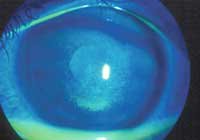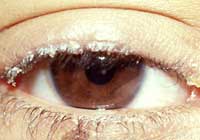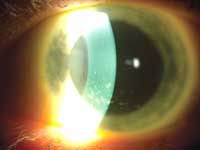ODs take new approaches to dry eye treatment
The management of dry eye disease has progressed in recent years from trying sometimes in vain to restore moisture in eyes with drops to centering on the reasons why the common affliction hits. A focus on diet and lifestyle also is helping practitioners better understand the disease.
“We’re looking at more of an understanding that it’s a progressive disease and there’s a need to treat it at an earlier stage,” Paul M. Karpecki, OD, FAAO, director of research in Cornea and External Disease Service at Cincinnati Eye Institute, said in an interview with Primary Care Optometry News. “We also realized the importance of targeting the disease.”
 Paul M. Karpecki |
Dry eye disease, either evaporative or tear-deficient, is characterized by several symptoms, including dryness, burning, foreign body sensation, grittiness, stinging and photophobia.
“In the past we would use a lot of artificial tears, which are still important, but wouldn’t target the root of the disease,” Dr. Karpecki said. “The disease progresses, even while on the best artificial tears. Now we’re looking more at options such as anti-inflammatory agents and immunomodulators.”
Practitioners also are turning to nutritional supplements to combat the effects of blepharitis and meibomian gland disease, especially fish and flaxseed oils.
“Taking flaxseed is something you can do so easily and it doesn’t have to be complicated or expensive,” Jeff Dougal, OD, who is in private practice in Placentia, Calif., told PCON in an interview.
The first step
Often a patient will turn to over-the-counter topical lubricating drops to treat their dry eyes, even before seeking professional advice.
“The difficulty is getting people to use artificial tears on a regular basis, which would be the simplest treatment there is,” Dr. Dougal said. “Very few people comply with the frequency they need, whether it’s every hour or two or more. Blinking is even more basic, and it’s really difficult to get any of us to do it frequently enough.”
Dr. Dougal said he counsels patients to blink more — at least once every 10 to 15 seconds. And he tells patients to try Optive (carboxymethylcellulose, Allergan) four times a day, at least one drop each time.
“I particularly like both Soothe (Bausch & Lomb, Rochester, N.Y.) and Optive,” Dr. Karpecki said. “They both have mild preservatives, as neither one has BAK [benzalkonium chloride].”
|
|
Images: Roth JM |
Nutritional advice
Dr. Karpecki starts treating dry eye from the waiting room. There, his patients fill out a detailed questionnaire that indicates everything from the number of hours of computer use to how much oily fish they consume weekly. The questionnaire also asks about patients’ caffeine and water intake and smoking habits, among other things.
“I can get a pretty good idea from that if I need to talk about omega-3 supplements,” Dr. Karpecki said. “Also intake of caffeinated beverages beyond about three to four caffeinated beverages a day becomes diuretic and you start to lose fluid. I recommend they increase their water intake.”
Dr. Karpecki said he recommends women take flaxseed in the form of Hydrate (OcuSoft, Richmond, Texas). Men appear to do better, he said, taking BioTears (Biosyntrx, Lexington, S.C.) fish oil supplements, and he recommends Lovaza, formerly known as Omacor (omega-3-acid ethyl esters, Reliant). He recommends 1,000 to 1,500 mg per day of each.
“It will often take an average of about 4 to 6 weeks before some patients will get a response,” he said. “Some will notice improvement in their skin and hair within the first few weeks.”
 Jeff Dougal |
Dr. Dougal said he has patients take 1,000 mg of flaxseed oil per day. “It’s inexpensive in a health food store,” he said.
If patients exhibit intestinal sensitivities, he prescribes TheraTears Nutrition supplements (Advanced Vision Research, Woburn, Mass.).
Gary Foulks, MD, also tells his patients to consider nutritional supplements, including daily vitamins. “I recommend omega-3 fatty acids to patients with meibomian gland disease but also to some patients who have aqueous deficient dry eye,” Dr. Foulks told PCON in an interview. He recommends two or three tablets a day of flaxseed or fish oil supplements.
As for lifestyle changes, “I’ll encourage people to not smoke, to include fish in their diet, tuna or deep water fishes,” Dr. Foulks said. “If they’re fad eaters or they don’t have a balanced diet, then I recommend nutritional supplements containing vitamin A or vitamin C. A lot of times they’ll elect to do that as part of a multivitamin.”
J. Mathis Dixon, OD, a private practitioner in Perry, Ga., also takes a complete history of patients to assess their nutritional intake. He recommends that patients come back in to see him for a follow-up examination. “The biggest mistake eye doctors make is to tell a patient his or her eyes are dry, give them a tear and tell them to come back next year,” he said in an interview.
He asks his patients to come back after 2 to 3 weeks of using artificial tears and nutritional omega-3 supplements.
“Upon follow-up, I perform a thorough dry eye assessment and determine if symptoms have improved,” he said. “I consider other treatment options such as punctal occlusion or Restasis.”
Dr. Dixon said he counsels his patients to avoid inexpensive, low quality products. “I like ProOmega by Nordic Naturals (Watsonville, Calif.) which is tolerated well by my patients.”
Other treatments
When deciding on a course of treatment, it is important to know what is causing the dry eye in the first place, either a lack of tears or too much evaporation.
 J. Mathis Dixon |
“The treatments overlap, but it’s good to keep the mechanism of what’s causing or contributing to the dry eye at the top of your mind when you’re treating these patients,” Dr. Foulks said.
When patients do not respond to palliative therapy, doctors may move on to topical or pharmaceutical treatments, sometimes using both together.
“We are starting to use more topical medications even before using Restasis (cyclosporine ophthalmic emulsion, Allergan), such as an anti-inflammatory – either a steroid with prednisolone topically or Lotemax (loteprednol etabonate 0.5%, Bausch & Lomb),” Dr. Dougal said. “A lot of experts say they are getting some benefit as a pre-treatment to reduce inflammation on the eye’s surface, and then switching to Restasis as a long-term treatment.”
Dr. Dougal uses topical therapy with obvious signs of inflammation and red, dry eyes. He also prescribes Pred Forte (prednisolone acetate 1%, Allergan) four times per day for a week, three times a day for another week and once a day for the last week.
“We’ve got a lot of products, a lot of options,” Dr. Dougal said. “Because dry eye seldom causes pain, the biggest problem is compliance.”
Dr. Karpecki said he uses Lotemax and Restasis in tandem.
“The lotoprednol has immediate impact on staining and symptoms,” he said. “And Restasis has long-term safety and increase in goblet cell density, so you have the best combination with the two. Some studies also show that Restasis increases tear volume.”
In the works
Excitement has been building for several years in the industry about diquafosol tetrasodium (Inspire Pharmaceuticals, Durham, N.C.), which has been shown to stimulate mucin and fluid production on the surface of the eye. Dr. Karpecki took part in several studies on the safety and efficacy of the drug.
“Inspire has met with the FDA several times in the past year,” according to a company statement. “Based on the most recent meeting in early 2007, Inspire has begun a process to validate that staining scores in the central region of the cornea are a clinically relevant endpoint for a clinical trial in dry eye patients.
“If Inspire is able to validate this endpoint and come to agreement with the FDA,” the statement continues, “the company expects to request a Special Protocol Assessment and initiate an additional clinical trial.”
Dr. Foulks said his experience with the drug in clinical trials was favorable. “When it is approved, I plan to use it in both mild and more severe dry eye, probably in conjunction with cyclosporine.”
Dr. Karpecki said it is difficult to get new products like this on the market, even when doctors witness very favorable results in clinical trials. “The trouble with dry eye studies is that the signs and symptoms don’t link up, which is part of the disease more than anything,” he said.
Research is also being conducted into topical androgens as a therapy for dry eye disease, Dr. Karpecki added.
Using doxycycline
Some practitioners also turn to oral doxycycline, a semi-synthetic tetracycline antibiotic.
|
Image: Karpecki P |
“When topical medicine doesn’t work, then I start with doxycycline,” Dr. Foulks said. He prescribes 100 mg twice a day for a week and then once a day for maintenance.
“I usually plan on using it for at least 2 months,” he said.
Dr. Karpecki said he uses oral hyclate doxycycline if a patient has telangecstasia (prominent blood vessels) or a history of internal hordeolum or lid disease that won’t respond to topical therapy.
Because doxycycline sometimes causes gastritis, Dr. Karpecki said patients should take a low dose of 20 mg. He prescribes the Alodox Convenience Kit (doxycycline hyclate 20 mg, Cynacon/OcuSoft), which also comes with OcuSoft lid scrub. He also has his patients take the second pill a few hours before going to bed. “If you take it and lie down, it will get lodged, and you’ll get a localized inflammatory response,” he said. “Do not take it with acidic beverages such as orange juice, apple juice or tomato juice. Stick to water.”
Patients should take the medicine with food but not dairy, Dr. Karpecki advised. “Calcium makes the drug totally ineffective,” he said. “It chelates it out.”
Dry mouth therapies
Some practitioners have found therapies for Sjögren’s syndrome also benefit dry eye patients, including the oral secretagogues Salagen (pilocarpine HCl, MGI Pharma) and Evoxac (cevimeline HCl, Daiichi). Both drugs stimulate saliva production.
“The benefit is much more prominent for dry mouth than for dry eye, and the side effects of sweating or the occasional upset stomach or diarrhea are usually not tolerated well,” Dr. Foulks said.
“I’ve really moved away from Salagen since Evoxac came along,” Dr. Karpecki said. “I wouldn’t prescribe it unless it was a Sjögren’s syndrome dry mouth patient; however, there are great dry eye benefits.
“Salagen also works, but in my experience I’ve had a lot of patients complain about the side effects, particularly scalp and back sweating,” he said.
Dr. Karpecki said he prescribes 30 mg of Evoxac three times a day.
Assess the lid, too
When treating a patient with dry eye disease, it is important to assess the lid as well, Dr. Karpecki said.
“When I get referrals, nine times out of 10 the reason they’re not responding to therapy is that they have meibomian gland dysfunction,” he said. “That is probably one of the most important diagnoses that an optometrist should make. Is it dry eye with lid disease, or is it dry eye without? If it is with lid disease, then that needs to be addressed first, and I address it with hot compresses and lid cleansers.”
Dr. Dougal said he encourages his patients with lid disease to use the lather from their own shampoo in the shower to clean their lids. He also tells patients to use disposable make-up removing pads on their lids and recommends OcuSoft’s Lid Scrub Eyelid Cleanser because it is a foam.
“If they truly have signs of blepharitis, they need to clean their lids on a daily basis. Twice a day would be better,” Dr. Dougal said.
Dr. Foulks said he also encourages patients to use hot compresses followed by a digital massage of the eyelid. “Any of the lid scrubs would be OK, too,” he said. “I also like Systane (Alcon, Fort Worth, Texas) and Optive. The Systane is mechanically protective whereas the Optive is osmotically protective.”
Dr. Karpecki said he prefers Zylet (tobramycin-loteprednol, Bausch & Lomb) for meibomianitis patients.
“It tends to accumulate in the oil glands,” he said. “It’s about 10 times more lipophillic than dexamethasone, a corticosteroid. You can use it four times a day for a week followed by twice a day for a week concurrently with the hot compresses once or twice a day. That seems to work in a lot of patients.”
For more information
- Paul M. Karpecki, OD, FAAO, is director of research in Cornea and External Disease Service for Cincinnati Eye Institute and a member of the Editorial Board of Primary Care Optometry News. He can be reached at 580 S. Loop Rd., Ste. 200, Edgewood, KY 41017; (859) 402-2814; fax: (859) 331-9040; e-mail: paulk-vc@kc.rr.com. Dr. Karpecki is a paid consultant for Allergan and Bausch & Lomb.
- Jeff Dougal, OD, can be reached at 1201 North Rose Dr., Suite 100, Placentia, CA 92870; (714) 528-2566; fax (714) 993-5369; e-mail: DougalDoc@aol.com. Dr. Dougal has no direct financial interest in the products he mentions, nor is he a paid consultant for any companies he mentions.
- Gary Foulks, MD, was a clinical investigator for diquafosol. He can be reached at 301 E. Muhammad Ali Blvd., Louisville, KY 40202; (502) 852-5466. Dr. Foulks has a direct financial interest in diquafosol and is a paid consultant for Inspire.
- J. Mathis Dixon, OD, can be reached at Advanced Eyecare, 1105 Morningside Dr., Perry, GA 31069; (478) 987-2020; fax: (478) 988-4628; e-mail: jmathisdixon@windstream.net. Dr. Dixon has no direct financial interest in the products he mentions, nor is he a paid consultant for any companies he mentions.



